Showing Spotlights 65 - 72 of 152 in category All (newest first):
 Every year, large quantities of antibiotics are released into lakes and rivers as a byproduct of their use in farming and medicine. Antibiotics in the environment can select for antibiotic-resistant bacterial populations, which can cause severe infections if they come into contact with humans or animals. In addition, antibiotics can disrupt the natural bacterial flora that plays a vital role in maintaining the balance of ecosystems. Scientists have now found that solar-powered proteoliposomes derived from bacteria can extract and store contaminants released into natural bodies of water,
Every year, large quantities of antibiotics are released into lakes and rivers as a byproduct of their use in farming and medicine. Antibiotics in the environment can select for antibiotic-resistant bacterial populations, which can cause severe infections if they come into contact with humans or animals. In addition, antibiotics can disrupt the natural bacterial flora that plays a vital role in maintaining the balance of ecosystems. Scientists have now found that solar-powered proteoliposomes derived from bacteria can extract and store contaminants released into natural bodies of water,
May 7th, 2013
 To date, the predominant focus of the nanotechnology risk research endeavor has been defining the fate, transport, and toxic properties of pristine or "as manufactured" nanomaterials. However, the high surface to volume ratio and reactivity of nanoparticles makes them highly dynamic in environmental systems. The resulting transformations of the nanomaterials will affect their fate, transport, and toxic properties. A recent review summarizes what is known about chemical, physical, and biologically mediated transformations of nanomaterials in natural systems and their effects on the resulting nanomaterial behavior.
To date, the predominant focus of the nanotechnology risk research endeavor has been defining the fate, transport, and toxic properties of pristine or "as manufactured" nanomaterials. However, the high surface to volume ratio and reactivity of nanoparticles makes them highly dynamic in environmental systems. The resulting transformations of the nanomaterials will affect their fate, transport, and toxic properties. A recent review summarizes what is known about chemical, physical, and biologically mediated transformations of nanomaterials in natural systems and their effects on the resulting nanomaterial behavior.
Jan 10th, 2013
 As nanotechnologies are beginning to empower our lives in so many ways, understanding the environmental health and safety aspect of nanotechnology has become a crucial issue. The lack of information on the impact of engineered nanomaterials on organisms and the environment motivates researchers all over the world to strive for a better understanding of the implications of nanotechnology applications. Researchers have now provided a mechanistic understanding on how nanomaterials affect zebrafish embryos development and specifically answers the question on what causes the embryos to fail hatching at due time.
As nanotechnologies are beginning to empower our lives in so many ways, understanding the environmental health and safety aspect of nanotechnology has become a crucial issue. The lack of information on the impact of engineered nanomaterials on organisms and the environment motivates researchers all over the world to strive for a better understanding of the implications of nanotechnology applications. Researchers have now provided a mechanistic understanding on how nanomaterials affect zebrafish embryos development and specifically answers the question on what causes the embryos to fail hatching at due time.
Dec 20th, 2012
 Researchers are applying various strategies to designing nanoscale propulsion systems by either using or copying biological systems such as the flagellar motors of bacteria or by employing various chemical reactions. Different practical micromotor applications, ranging from drug delivery, to target isolation and environmental remediation, have thus been reported over the past 2-3 years. Yet, there are no reports on a nanomachine-based toxicity assay approach, analogous to the use of live aquatic organisms for testing the quality of our water resources.
Researchers are applying various strategies to designing nanoscale propulsion systems by either using or copying biological systems such as the flagellar motors of bacteria or by employing various chemical reactions. Different practical micromotor applications, ranging from drug delivery, to target isolation and environmental remediation, have thus been reported over the past 2-3 years. Yet, there are no reports on a nanomachine-based toxicity assay approach, analogous to the use of live aquatic organisms for testing the quality of our water resources.
Dec 19th, 2012
 Increasingly we are observing glass windows as a key building material in modern construction design. Specially in the urban areas presence of high rise residential and commercial buildings are clearly visible. At the same time, it is important to make this increasing urbanization as green as possible. With an increase in building height, its power consumption rises not only because of the presence of more people but also because lifting water, operating elevators, etc. require extra amounts of power. Therefore, developing a complementary source of power which is clean and otherwise wasted is a key research topic for a sustainable future. Researchers at KAUST explored a novel idea to integrate micro- to nanoscale thermoelectric materials with the window glasses to generate thermoelectricity based on the temperature difference that exists between the hot outside and relatively cold inside.
Increasingly we are observing glass windows as a key building material in modern construction design. Specially in the urban areas presence of high rise residential and commercial buildings are clearly visible. At the same time, it is important to make this increasing urbanization as green as possible. With an increase in building height, its power consumption rises not only because of the presence of more people but also because lifting water, operating elevators, etc. require extra amounts of power. Therefore, developing a complementary source of power which is clean and otherwise wasted is a key research topic for a sustainable future. Researchers at KAUST explored a novel idea to integrate micro- to nanoscale thermoelectric materials with the window glasses to generate thermoelectricity based on the temperature difference that exists between the hot outside and relatively cold inside.
Nov 22nd, 2012
 Buildings and other man-made structures consume as much as 30-40% of the primary energy in the world, mainly for heating, cooling, ventilation, and lighting. 'Smart' windows are expected to play a significant role in reducing the energy consumption of homes in two ways: by generating energy themselves; and by providing better insulation by allowing light in and keeping the heat out (in hot summers) or in (in cold winters). Vanadium dioxide (VO2) has long been recognized as a a material of significant technological interest for optics and electronics and a promising candidate for making 'smart' windows: it can transition from a transparent semiconductive state at low temperatures, allowing infrared radiation through, to an opaque metallic state at high temperatures, while still allowing visible light to get through. In new work, researchers have now offered a simple method for promoting the production of monoclinic VO2 nanoparticles by doping.
Buildings and other man-made structures consume as much as 30-40% of the primary energy in the world, mainly for heating, cooling, ventilation, and lighting. 'Smart' windows are expected to play a significant role in reducing the energy consumption of homes in two ways: by generating energy themselves; and by providing better insulation by allowing light in and keeping the heat out (in hot summers) or in (in cold winters). Vanadium dioxide (VO2) has long been recognized as a a material of significant technological interest for optics and electronics and a promising candidate for making 'smart' windows: it can transition from a transparent semiconductive state at low temperatures, allowing infrared radiation through, to an opaque metallic state at high temperatures, while still allowing visible light to get through. In new work, researchers have now offered a simple method for promoting the production of monoclinic VO2 nanoparticles by doping.
Aug 27th, 2012
 Nanotechnology products, processes and applications have the potential to make important contributions to environmental and climate protection by helping save raw materials, energy and water as well as by reducing greenhouse gases and problematic wastes. Great hopes are being placed on nano-technologically optimized products and processes that are currently under development in the energy production and storage sectors. Emphasis is often placed on the sustainable potential of nanotechnology, but this in fact represents a poorly documented expectation. Determining a product's actual effect on the environment - both positive and negative - requires considering the entire life cycle from the production of the base materials to disposal at the end of its useful life. Not every 'nano-product' is a priori environmentally friendly or sustainable, and the production of nanomaterials often requires large amounts of energy, water and environmentally problematic chemicals.
Nanotechnology products, processes and applications have the potential to make important contributions to environmental and climate protection by helping save raw materials, energy and water as well as by reducing greenhouse gases and problematic wastes. Great hopes are being placed on nano-technologically optimized products and processes that are currently under development in the energy production and storage sectors. Emphasis is often placed on the sustainable potential of nanotechnology, but this in fact represents a poorly documented expectation. Determining a product's actual effect on the environment - both positive and negative - requires considering the entire life cycle from the production of the base materials to disposal at the end of its useful life. Not every 'nano-product' is a priori environmentally friendly or sustainable, and the production of nanomaterials often requires large amounts of energy, water and environmentally problematic chemicals.
Jul 11th, 2012
 The global cement industry is currently one of the largest single emitter of carbon dioxide, generating on average about 830 kg of this greenhouse gas for each 1000 kg of cement produced. Considering that the worldwide annual production of cement is a whopping 3.8 trillion kg, the cement industry alone accounts for approximately 5-6% of man-made CO2 emissions. Researchers have now presented a solar-powered process to produce cement without any carbon dioxide. In their STEP (Solar Thermal Electrochemical Production) process, cement limestone undergoes low energy electrolysis to produce lime, O2 and reduced carbonate without carbon dioxide emission. In this new technique, the kiln limestone-to-lime process is replaced by an electrolysis process which changes the product of the reaction of the limestone as it is converted to lime.
The global cement industry is currently one of the largest single emitter of carbon dioxide, generating on average about 830 kg of this greenhouse gas for each 1000 kg of cement produced. Considering that the worldwide annual production of cement is a whopping 3.8 trillion kg, the cement industry alone accounts for approximately 5-6% of man-made CO2 emissions. Researchers have now presented a solar-powered process to produce cement without any carbon dioxide. In their STEP (Solar Thermal Electrochemical Production) process, cement limestone undergoes low energy electrolysis to produce lime, O2 and reduced carbonate without carbon dioxide emission. In this new technique, the kiln limestone-to-lime process is replaced by an electrolysis process which changes the product of the reaction of the limestone as it is converted to lime.
Apr 11th, 2012
 Every year, large quantities of antibiotics are released into lakes and rivers as a byproduct of their use in farming and medicine. Antibiotics in the environment can select for antibiotic-resistant bacterial populations, which can cause severe infections if they come into contact with humans or animals. In addition, antibiotics can disrupt the natural bacterial flora that plays a vital role in maintaining the balance of ecosystems. Scientists have now found that solar-powered proteoliposomes derived from bacteria can extract and store contaminants released into natural bodies of water,
Every year, large quantities of antibiotics are released into lakes and rivers as a byproduct of their use in farming and medicine. Antibiotics in the environment can select for antibiotic-resistant bacterial populations, which can cause severe infections if they come into contact with humans or animals. In addition, antibiotics can disrupt the natural bacterial flora that plays a vital role in maintaining the balance of ecosystems. Scientists have now found that solar-powered proteoliposomes derived from bacteria can extract and store contaminants released into natural bodies of water,
 Subscribe to our Nanotechnology Spotlight feed
Subscribe to our Nanotechnology Spotlight feed





